
Mahonia aquifolium, the Oregon grape or holly-leaved barberry, is a species of flowering plant in the family Berberidaceae, native to western North America. It is an evergreen shrub growing 1–3 meters tall and 1.5 m (5 ft) wide, with pinnate leaves consisting of spiny leaflets, and dense clusters of yellow flowers in early spring, followed by dark bluish-black berries.

Berberis, commonly known as barberry, is a large genus of deciduous and evergreen shrubs from 1–5 m (3.3–16.4 ft) tall, found throughout temperate and subtropical regions of the world. Species diversity is greatest in South America and Asia; Europe, Africa and North America have native species as well. The best-known Berberis species is the European barberry, Berberis vulgaris, which is common in Europe, North Africa, the Middle East, and central Asia, and has been widely introduced in North America. Many of the species have spines on the shoots and all along the margins of the leaves.

Berberis darwinii, Darwin’s barberry, is a species of flowering plant in the family Berberidaceae, native to southern Chile and Argentina and naturalized elsewhere. Regional vernacular names include michay, calafate, and quelung. Growing to 3–4 m (9.8–13.1 ft) tall, it is an evergreen thorny shrub.
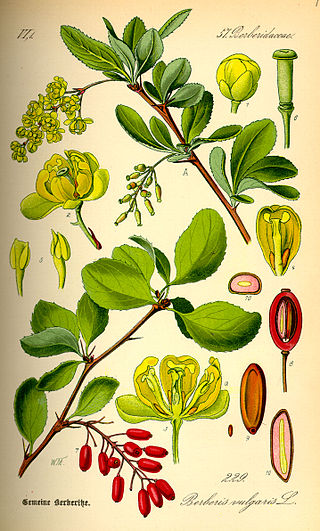
Berberis vulgaris, also known as common barberry, European barberry or simply barberry, is a shrub in the genus Berberis native to the Old World. It produces edible but sharply acidic berries, which people in many countries eat as a tart and refreshing fruit.
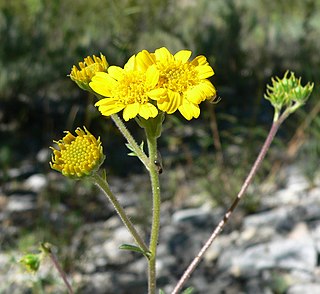
Hymenothrix is a small genus of North American flowering plants in the daisy family known as thimbleheads. They are native to the southwestern United States and northern Mexico.

Brickellia californica, known by the common name California brickellbush, is a species of flowering plant in the family Asteraceae.
Antennaria geyeri is a North American species of flowering plant in the family Asteraceae known by the common name pinewoods pussytoes or mountain pussytoes. It is native to the western United States where it grows in woodland and scrub very often on the forest floor under pine trees. It is found in Washington, Oregon, northern California, and northwestern Nevada.
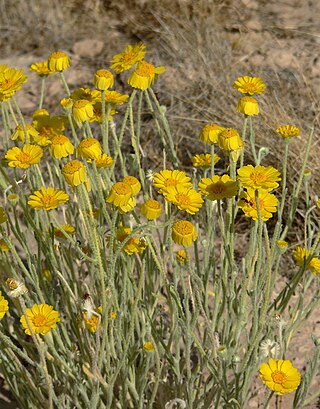
Baileya pleniradiata is a North American species of flowering plant in the daisy family, known by the common name woolly desert marigold. It is native to desert regions of the southwestern United States and northern Mexico, where it grows in sandy habitats. It has been found in the States of Chihuahua, Sonora, Baja California, Arizona, Utah, and Nevada.
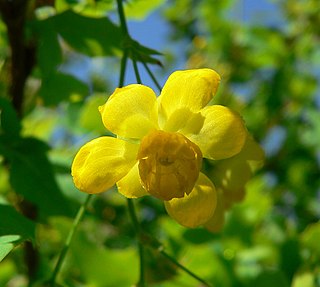
Mahonia fremontii is a species of barberry known by the common name Frémont's mahonia.

Carphochaete is a genus of North American flowering plants in the family Asteraceae. They are native to Mexico and the southwestern United States. They are known commonly as bristleheads.

Haploesthes is a North American genus of flowering plants in the family Asteraceae. It grows in Mexico and in the southwestern United States. They are perennial herbs or subshrubs with yellow flower heads.

Ribes leptanthum is a spiny-stemmed, small-leaved species of gooseberry in the genus Ribes commonly called trumpet gooseberry. It is native to Arizona, Colorado, New Mexico, Texas, and Utah, where it is usually found in high-altitude canyons.
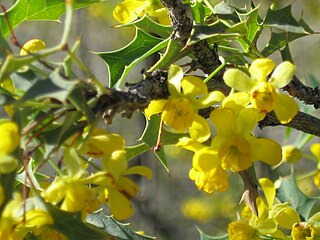
Berberis harrisoniana is a rare species of flowering plant in the barberry family, Berberidaceae. It is known by the common names Kofa barberry, Kofa Mountain barberry, Harrison's barberry, and red barberry.

Berberis haematocarpa, Woot. with the common names red barberry, red Mexican barbery, Colorado barberry and Mexican barberry, is a species in the Barberry family in southwestern North America. It is also sometimes called algerita, but that name is more often applied to its relative, Mahonia trifoliolata.

Ambrosia salsola, commonly called cheesebush, winged ragweed, burrobush, white burrobrush, and desert pearl, is a species of perennial shrub in the family Asteraceae native to deserts of the southwestern United States and northwestern Mexico.
Galium fendleri, Fendler's bedstraw, is a plant species in the Rubiaceae. It has yellow flowers and is native to Sonora, Arizona, New Mexico, and Texas.

Hymenothrix wislizeni, the Trans-Pecos thimblehead, is a North American species of flowering plant in the daisy family. It grows in northwestern Mexico and the southwestern United States.

Gaylussacia ursina, the bear huckleberry, is a plant species native to the southern Appalachians.

Argyrochosma fendleri, Fendler's false cloak fern, is a fern known from the western United States and northwestern Mexico. It grows in rocky habitats, and is distinguished from other members of the genus by its zig-zag leaf axes. Like many species in the genus, it bears white powder on the underside of its leaves. First described as a species in 1851, it was transferred to the new genus Argyrochosma in 1987, recognizing their distinctness from the "cloak ferns".

Echinocereus enneacanthus is a species of flowering plant first described by George Engelmann.


















